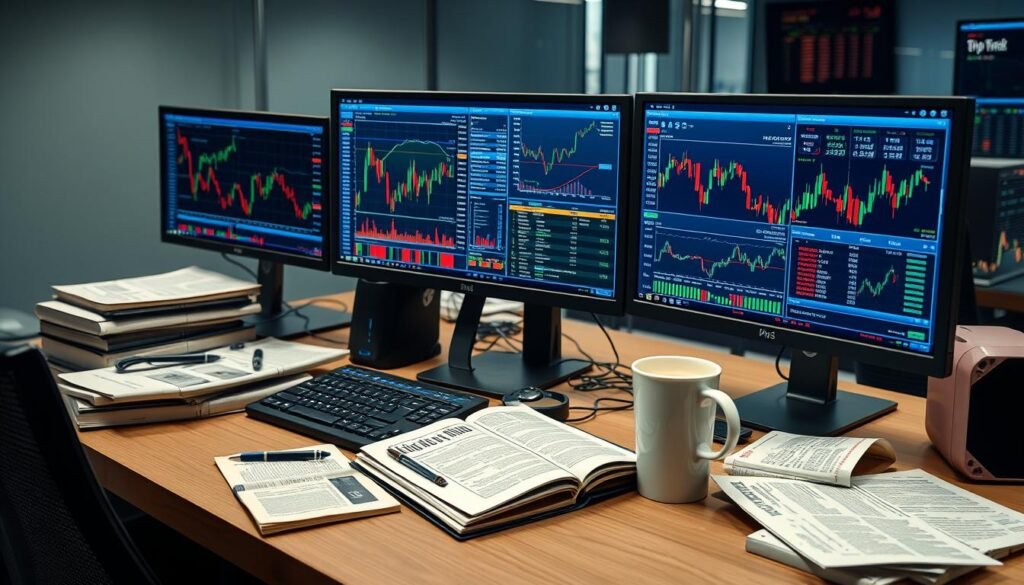Ever wondered how much money you can make trading for a prop firm? The idea of prop trading income potential is both intriguing and shrouded in mystery. This article will shed light on the world of high-stakes finance, uncovering the secrets of proprietary trading salary and the factors that influence prop trading firm earnings.
If you dream of becoming a trader or are already one, knowing how you’re paid is key. We’ll take a closer look at the earning potential in prop firms, from newbies to seasoned pros. You’ll learn about the profits, challenges, and obstacles that can affect a trader’s success.
Every level in the prop trading world offers different earning chances and challenges. These are shaped by experience, strategies, and market trends. This introduction sets the stage for a deep dive into the economics of prop trading.
Key Takeaways
- Understanding the range of earnings possible within proprietary trading firms
- Factors that affect a prop trader’s salary and overall compensation
- Comparing the earning potential at different stages of a trading career
- The influence of market conditions on prop trading firm earnings
- Insights on how to navigate and maximize the proprietary trading salary landscape
Understanding Proprietary Trading
Proprietary trading, or prop trading, means firms use their own money to buy financial products. They don’t use their clients’ money. This way, they keep all the profits for themselves. Knowing how prop trading works helps understand how traders get paid and the financial world.
What is Proprietary Trading?
Firms use different strategies like swing and arbitrage trading to make money. This is different from traditional trading where brokers just get commissions. In prop trading, the salary depends on the success of the trades with the firm’s money. This gives traders a direct interest in their work.
The Role of a Prop Trader
A prop trader uses the firm’s money to make trades, hoping to profit from market changes. Their earnings depend on their success, skill, and the firm’s support. So, how well they do and the firm’s help both affect their pay.
Prop Firms vs. Traditional Brokerages
Prop firms make money from their trading, unlike brokerages that charge clients. This makes prop trading salaries potentially higher but also riskier. Traders get paid based on their profits, linking their earnings to their skills and market conditions.
It’s important to understand the basics of proprietary trading for a career in finance. Prop trading offers the chance to trade aggressively and earn a big share of the profits. It’s a field that attracts many ambitious traders.
Basics of Prop Trading Firm Earnings
Every prop trading firm has its own way of paying its traders. Knowing how they calculate and share earnings is key for those thinking about a career in finance.
Earnings in prop trading firms depend on two main things: prop trading profit share and prop trading payouts. These are the money traders get based on how well they do and the firm’s profit plans.
- Salary Base: Some firms give a base salary. This helps new traders by providing a steady income, no matter their trading results.
- Bonuses: Bonuses are tied to how well a trader does. They can really boost a trader’s earnings, especially when the market is good.
- Prop Trading Profit Share: This is a part of the profits from trading that goes to the trader. The percentage can change a lot, depending on the trader’s experience and the contract.
- Prop Trading Payouts: These are the actual payments to traders. They usually happen monthly or quarterly. They show what the trader gets after fees and costs are taken out.
Every prop trading firm has its own rules for profit shares and payouts. Some offer more upfront salary but lower profit percentages. Others might not have a base salary but offer higher profit shares.
For those new to proprietary trading, understanding these income parts is crucial. It helps make smart career choices and find success in the industry.
Entry-Level Prop Trader Salary
Starting a career in prop trading means looking at the financial rewards, especially for beginners. The first pay can change a lot based on different things. We’ll look at these factors below.
Salary Components for New Traders
At first, the trader salary prop trading setup has a base pay plus bonuses based on performance. For newbies, the base pay helps them financially as they learn. Bonuses then kick in to reward good trading and profits.
| Component | Description | Typical Range |
|---|---|---|
| Base Salary | Guaranteed annual income | $45,000 – $65,000 |
| Bonuses | Dependent on personal and firm performance | 10% – 50% of profits generated |
| Training & Development | Resources provided to enhance skills | Included |
Impact of Market Experience
Market experience is key, even for new traders. Those with internships or financial market experience might start with higher salaries. This shows they can help the firm make money faster, which is good for everyone.
Knowing about these pay parts helps you see what’s ahead. It also shows how to start a profitable career in prop trading.
Experienced Prop Trader Compensation
In the world of proprietary trading, experienced traders have a big edge when it comes to prop trading compensation. They use their advanced skills and deep market knowledge to boost their prop trading income potential. Let’s explore what makes their compensation structures stand out.
Skills That Influence Senior Trader Salaries
Skills like advanced analysis, risk management, and quick decision-making are key for senior traders. Those who consistently perform well and adapt to market changes earn more.
How Bonuses Affect Overall Income
Bonuses are a big part of a senior prop trader’s income. They are often tied to performance and can greatly increase base pay. This depends on both individual and company success.
Bonuses also motivate traders to do better. They help prop trading firms push their traders to meet or exceed goals. This means a trader’s income can grow a lot when the market is good.
- Quantitative Analysis
- Risk Management Proficiency
- Adaptability to Market Changes
- Problem-Solving Skills
These skills not only help traders earn more but also give them an edge in negotiations. This way, the prop trading income potential for experienced traders can grow and become more varied.
How Much Can You Make Trading for a Prop Firm?
Looking into prop firm trader earnings gives us a peek into the finance world. Here, numbers often tell the story better than words. Many wonder, how much can you make trading for a prop firm?

Prop trading is a big part of finance, with earnings based on skill, experience, and strategy. But, people want to know the exact figures. Let’s explore what affects earnings and what salary ranges are realistic.
| Experience Level | Average Annual Earnings |
|---|---|
| Junior Trader | $50,000 – $70,000 |
| Mid-Level Trader | $100,000 – $150,000 |
| Senior Trader | $200,000+ |
As shown, prop firm trader earnings grow with experience. New traders start with a salary and bonuses based on performance. This can greatly increase their earnings as they get better at trading.
Also, many prop firms give extra benefits like trading tools and training. These don’t directly add to your income but help you do better. This can lead to higher earnings.
In the end, how much can you make trading for a prop firm depends on your skills, the market, and the firm’s rules. For those aiming high, the sky’s the limit in a trading career.
Revenue Split Models in Prop Trading
In prop trading, the prop trading profit share deal is key to a trader’s earnings. These deals aim to boost the firm’s success and reward traders with a big share of profits. Knowing these models is vital for anyone in prop trading or looking to boost their earnings.
The split in proprietary trading profits can range from 50% to 90%. This depends on the trader’s skill, the risk, and the firm’s policies. Understanding these agreements can greatly affect a trader’s proprietary trading salary and financial goals.
For new traders, these splits mean they might not earn much at first. But, they have a big chance to increase their earnings through successful trades. More skilled traders can get better deals, showing their ability to make consistent profits.
For more details on these profit sharing models, check out this dedicated prop trading resource. It provides in-depth information on how these models work and their benefits for both traders and firms.
| Experience Level | Typical Profit Share |
|---|---|
| New Traders | 50% – 60% |
| Intermediate Traders | 60% – 75% |
| Experienced Traders | 75% – 90% |
The prop trading profit share model gets better as traders gain experience and show their profit-making skills. This model motivates traders to improve their strategies and aligns their success with the firm’s.
In conclusion, whether you’re an experienced trader or just starting, understanding the prop trading profit share deal is crucial. It can greatly impact your proprietary trading salary. It’s about finding a balance that benefits both the trader and the firm.
Understanding Profit Share Agreements
Profit-sharing agreements are key in prop trading compensation. They outline how profits are split and what performance metrics are important for success. This is why many are drawn to this career.
Typical Profit Sharing Percentages
In proprietary trading, profit-sharing percentages vary. They depend on the firm’s size, policy, and the trader’s agreement. Usually, traders get between 20% to 50% of their profits. This range shows the different strategies and levels of trader experience.
Negotiating Your Share
Negotiating your profit share is crucial for better earnings in proprietary trading. Here are some tips for discussing profit share:
- Understand the benchmarks – Know the industry standards to ensure your offer is competitive.
- Present your value – Show off your successful trading strategies or profits. This can help in negotiations.
- Consider long-term potential – Sometimes, accepting a lower initial percentage for future gains is worth it.
By negotiating well, you can increase your prop trading compensation. This leads to better income potential.
Prop Trading Payouts and Frequency
Knowing how prop trading payouts work is key for traders. They get money through salary, bonuses, and a share of profits. This part talks about how prop trading firms pay out and how it impacts a trader’s money.
Methods of Payout:
- Monthly Salary: A steady income that doesn’t change.
- Quarterly Bonuses: Based on the firm’s profits and your performance.
- Annual Profit Sharing: The biggest part of prop trading firm earnings, paid at the end of the year.
Each prop trading firm has its own way of paying out. But they all aim to motivate traders to do their best. Here’s a table showing how often and why payouts happen:
| Payout Type | Frequency | Dependency |
|---|---|---|
| Monthly Salary | Monthly | Fixed rate, no matter the trading results |
| Quarterly Bonuses | Quarterly | How well you trade and the firm’s profits |
| Annual Profit Share | Annually | The firm’s total profit for the year |
This setup means traders get a steady income each month. But bonuses and profit shares push them to aim for both short-term wins and the firm’s long-term success. It makes personal and company goals align.
In short, the regular and performance-based payouts in prop trading are crucial for financial planning. Knowing when and how these payouts are made is vital. It helps with budgeting and planning your career in proprietary trading.
Factors Influencing Prop Trading Income Potential
Exploring prop trading? It’s key to know what affects your earnings. This includes your skills, the market, and your strategies. Each plays a big role in how much you can make.
Market Conditions and Earnings
Market ups and downs greatly affect your income. When markets are volatile, there are more chances to make money. This is because there’s more activity and price changes.
But, in calm markets, making money can be harder. Traders need to adjust their plans to keep earning well.
Trader’s Performance Metrics
How well you do in prop trading matters a lot. Firms look at your profit and loss, risk-taking, strategy-making, and how you adapt to changes. These help them see how you’re doing now and how you might do in the future.
| Performance Metric | Description | Impact on Income |
|---|---|---|
| Profit and Loss (P&L) | Tracking the net gain or loss achieved by a trader. | Directly correlates with bonus and revenue share. |
| Risk Assessment | Evaluation of risk per trade relative to potential return. | Better risk management often leads to more stable earnings. |
| Market Adaptation | Ability to shift strategies based on market behavior. | Favors long-term sustainability and income consistency. |
Prop trading income can vary a lot. But, knowing these key points can help you boost your earnings. Focus on improving your skills and strategies. The right mix of your abilities and market conditions can open up great earning possibilities.
Maximizing Earnings with the Right Prop Firm
Choosing the right prop trading firm is key to making more money. It’s all about the firm’s reputation, support, and how it helps you grow. Here are tips to pick a firm that boosts your earnings:
- Reputation: Go for firms known for being honest and doing well. A good reputation means better growth and more money.
- Support structures: Look for firms with great tech, learning tools, and mentorship.
- Training opportunities: Learning helps you get better at trading. This can lead to more money.
- Cultural fit: Choose a firm that shares your values. A good fit makes you work better.

| Feature | Impact on Prop Trading Firm Earnings |
|---|---|
| Advanced Trading Platforms | Makes trading more efficient and can increase profits. |
| Profit Sharing Model | Tells you how much of the profits you get. |
| Professional Development | Helps you get better and keep up with market changes, which can raise your earnings. |
| Market Access | More markets mean more chances to make money. |
Knowing how prop trading firm earnings work and how your work place affects you is important. Don’t just look at the money. Think about how the firm helps you grow and succeed.
The Impact of Trading Strategies on Earnings
Understanding how trading strategies affect prop trading compensation is key for traders wanting to boost their earnings. Different strategies can greatly change prop trading income potential. This depends on how well they match market conditions and the goals of prop firms.
Skilled traders often adjust their strategies based on detailed analysis and market knowledge. The type of strategy they use—conservative, moderate, or aggressive—can greatly impact their earnings. We’ll look at several strategies used in the industry and how they might affect trader compensation.
- Scalping: This strategy involves making many trades in a day, aiming for small profits. It works well in strong or stable markets, which can increase traders’ income chances.
- Swing Trading: Swing traders take advantage of market momentum, holding positions for days to weeks. This strategy can lead to big gains, boosting earnings.
- Position Trading: Position trading is a long-term approach, holding assets for months to years. It offers growth potential but may not affect earnings right away.
- Algorithmic Trading: Traders using algorithms can automate trades, making profits faster and more efficiently. This can greatly increase profitability and prop trading compensation.
Each strategy has its own risks and is best suited for certain traders. Prop firms help traders choose strategies that fit their style and goals. This is crucial for maximizing prop trading income potential.
The choice of strategy not only affects earnings but also shapes a trader’s career in the proprietary trading sector. Therefore, matching personal skills with effective strategies is vital for success in this fast-paced field.
Annual Income Trends for Prop Traders
The world of proprietary trading salaries has changed a lot in recent years. Looking at industry data, we see important trends. These trends help both new and experienced traders understand what they might earn.
Industry Benchmarks and Expectations
Now, prop firm trader earnings are clearer thanks to a more open and competitive market. Data helps set clear income expectations for everyone. This is true for both new and seasoned traders.
Influence of Economic Cycles
Economic conditions greatly affect prop trader earnings. When markets boom, so do trader incomes. But during recessions, incomes drop.
| Year | Median Proprietary Trading Salary | Top 10% Earnings |
|---|---|---|
| 2019 | $85,000 | $160,000 |
| 2020 | $88,000 | $175,000 |
| 2021 | $92,000 | $190,000 |
| 2022 | $94,000 | $200,000 |
Realistic Earnings vs. Common Myths
Exploring how much can you make trading for a prop firm requires separating fact from fiction. Many new traders have high hopes, influenced by myths. It’s important to understand the real prop trading firm earnings.
Dispelling Misconceptions About Prop Trading
Many believe all prop traders start with huge salaries, like six or seven figures. But, these high earnings are rare. They usually go to experienced traders who are among the best in the industry.
What Top Percentile Traders Really Earn
Let’s look at what top 10% of traders at well-known prop firms make. Their earnings show the potential of the market. But, they also highlight the need for hard work and skill.
| Year | Median Earnings | Top 10% Earnings |
|---|---|---|
| 2022 | $125,000 | $250,000+ |
| 2023 | $130,000 | $270,000+ |
These figures are before taxes and require a lot of time and effort. Traders need to deeply understand the market and keep their portfolios in top shape.
Benefits and Perks of Trading with a Prop Firm
Looking into prop trading benefits shows more than just good money-making chances. Prop trading firms give many perks that help traders grow both personally and professionally. These benefits help traders make money and also make their work life better.
- Advanced Trading Tools and Technology: Access to top-notch trading software and tools, which can be very expensive for solo traders.
- Comprehensive Training Programs: Ongoing learning and development chances that improve trading skills and strategies.
- Supportive Community: Being part of a team that supports and networks among both experienced and new traders.
- No Capital Contribution Required: Traders can work with big leverage without needing to invest their own money, lowering personal risk.
These perks together boost a trader’s earning potential and skills. This makes prop trading benefits a big draw, not just for the money but for career growth chances too.
Risks and Challenges in Proprietary Trading
Proprietary trading offers big rewards, but it also comes with big risks. One major challenge is market risk. Financial markets can change quickly, requiring traders to be quick to adapt.
Managing these risks is key to success. It’s about balancing the chance for profit with the risk of loss. Traders need to make smart decisions, even when it’s hard.
Traders also face a lot of pressure. They are alone in their losses and are always compared to others. This can be very stressful.
Traders need to be strong and keep improving. They must stay focused and work hard to do better than others.
Looking at the bright side of prop trading, it’s important to know the challenges. Understanding how to manage risks is as crucial as making profits. Anyone thinking about this career must be ready for the challenges and the rewards.












